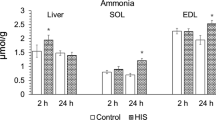Summary
In the muscles of 150 extremities of Wistar rats (weight 200 to 240 g) ischaemia was produced by a rubber tourniquet and post-ischaemic recovery allowed after the circulation was released. The animals were kept in ether-Inaktin anaesthesia at a constant room temperature of 28° C. The blood temperature fell insignificantly while the temperature of the ischaemic limb was distinctly lowered and approached the environmental temperature after 5 h. Blood pressure and pulse were recorded continuously. In controls ATP was found to be 6.3, with low ADP and AMP, PKR 17.3 and glycogen 42.87 μmol/g Fg, in the range of known normal values. In ischaemia, in agreement with findings in other organs, ATP falls to 12% after 3 h PKR after 1 h is 2.4% and after 2 h barely demonstrable. Capacity of recovery is clearly dependant on the ischaemia. There is still a definite capacity of resynthesis after 3 h. For instance, ATP after 2 h ischaemia and 2 h recovery rises again to ca. 86% of the control value. After 3 h the capacity of rapid recovery is definitely impaired. In contrast to the recovery after 2 h ischaemia, no normal PKR values are reached after 3 h ischaemia. Glycogen is completely broken down during anaerobiosis and can be resynthesized after 2 h ischaemia and 2 h recovery. The capacity of recovery after 4 and 5 h ischaemia is at present being investigated in long-period experiments. Results obtained so far suggest that for sufficient postischaemic recovery the limit of complete ischaemia is between 3 and 4 h.
Zusammenfassung
In der Muskulatur von 150 Extremitäten von Wistarratten (Gewicht 200–240 g) wurde durch einen Gummitourniquet eine Ischamie erzeugt und nach Wiederfreigabe der Strombahn eine postischämische Erholung ermög licht. Die Tiere wurden in Äther-Inaktin-Narkose bei konstanter Raumtemperatur von 28° C gelagert. Dabei fiel die Kerntemperatur unwesentlich ab, während die Temperatur der ischämischen Extremität deutlich vermindert war und sich nach 5 Std der Umgebungstemperatur anndherte. Blutdruck und Puls wurden fortlaufend blutig kontrolliert.
Bei Kontrollen wurde ein ATP von 6,3 bei niedrigem ADP und AMP, ein PKR von 17,3 sowie ein Glykogen von 42,87 μmol/g Fg im Bereich der bekannten Normwerte gefunden. In der Ischamie fällt in Übereinstimmung mit Befunden an anderen Organen das ATP ab und betragt nach 3 Std 12%.
Das PKR betragt nach 1 Std 2,4% und ist nach 2 Std an der Grenze der Nachweisbarkeit.
Die Erholungsfähigkeit steht in deutlicher Abhängigkeit zur Ischamie, wobei nach 3 Std noch eine ausgesprochene Fähigkeit zur Resynthese besteht. Zum Beispiel ist das ATP nach 2 Std Ischämie und nach 2 Std Erholung wieder auf ca. 86% des Kontrollwertes angestiegen. Nach 3 Std ist die Fähigkeit zur raschen Erholung deutlich eingeschränkt. So werden im Gegensatz zur Erholung nach 2 Std Ischämie keine normalen PKR-Werte nach 3stündiger Ischamie erreicht. Das Glykogen wird in der Anaerobiose vollständig abgebaut und kann nach 2stün-diger Ischamie und 2stündiger Erholung wieder deutlich synthetisiert werden. Die Erholungsfähigkeit nach 4- und 5stündiger ischämischer Belastung wird zur Zoit in Langzeitversuchen geklärt. Die bisherigen Ergebnisse legen nahe, daß für eine ausreichende postischämische Erholung die Grenze einer kompletten Ischamie zwischen 3 und 4 Std liegt.
Similar content being viewed by others
Author information
Authors and Affiliations
Rights and permissions
About this article
Cite this article
Stock, W., Bohn, J. & Isselhard, W. 287. Energiereiche Phosphate und Glykolyse der Skeletmuskulatur der Ratte bei Ischamie und in der postischämischen Erholung. Langenbecks Arch Chiv 329, 1039–1040 (1971). https://doi.org/10.1007/BF01770720
Published:
Issue Date:
DOI: https://doi.org/10.1007/BF01770720




